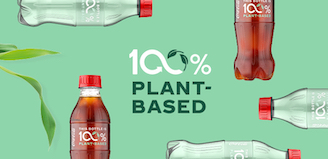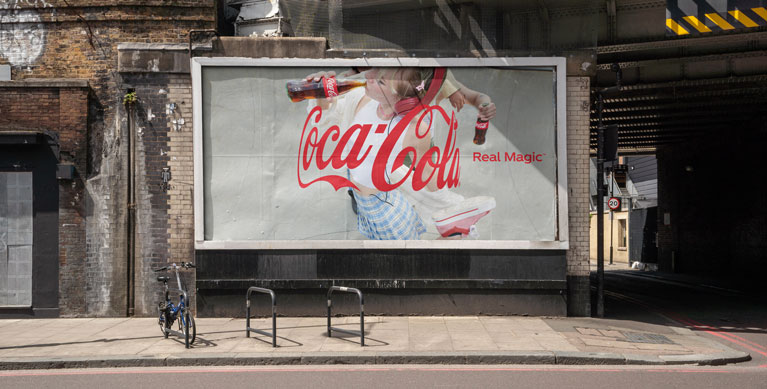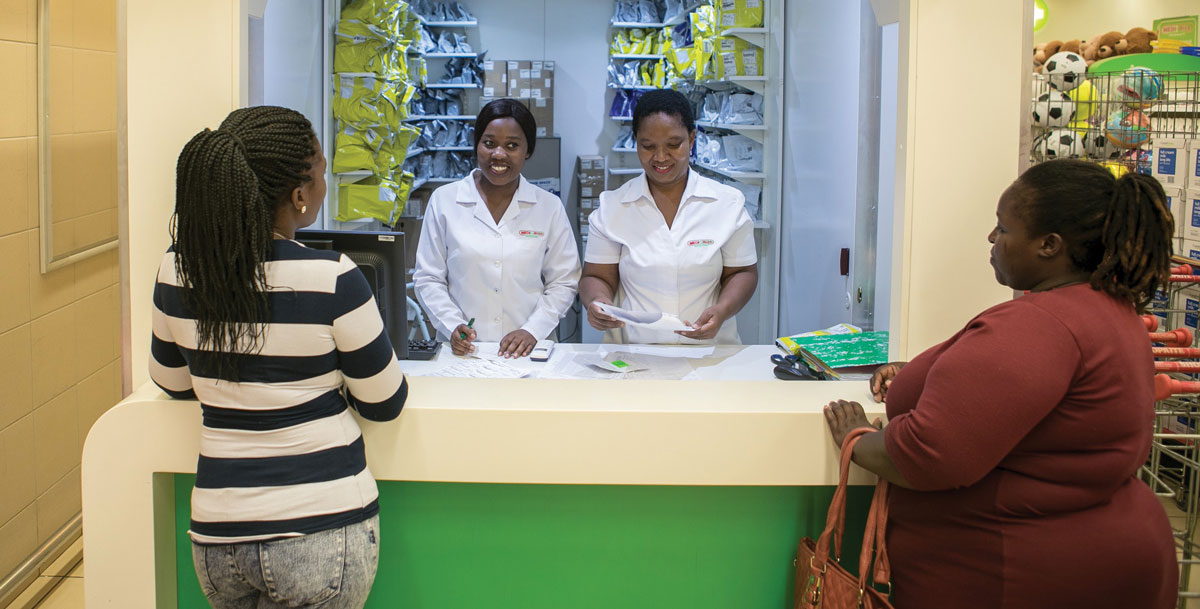Coca‑Cola Reports Fourth Quarter and Full Year 2020 Results
02-11-2021
Global Unit Case Volume Declined 3% for the Quarter and 6% for the Full Year
Net Revenues Declined 5% for the Quarter and 11% for the Full Year;
Organic Revenues (Non-GAAP) Declined 3% for the Quarter and 9% for the Full Year
Operating Income Grew 8% for the Quarter and Declined 11% for the Full Year; Comparable Currency
Neutral Operating Income (Non-GAAP) Grew 14% for the Quarter and Was Even for the Full Year
Fourth Quarter EPS Declined 29% to $0.34, and Comparable EPS (Non-GAAP) Grew 6% to $0.47;
Full Year EPS Declined 13% to $1.79, and Comparable EPS (Non-GAAP) Declined 8% to $1.95
Cash from Operations Was $9.8 Billion for the Full Year, Down 6%;
Full Year Free Cash Flow (Non-GAAP) Was $8.7 Billion, Up 3%
Company Provides 2021 Financial Outlook
ATLANTA, Feb. 10, 2021 – The Coca‑Cola Company today reported fourth quarter and full year 2020 results, including sequential improvement in volume trends. The company also provided an update on its strategic transformation initiatives. Together with its bottling partners, the company continues to focus on moving swiftly to execute against system priorities and to win in the marketplace.
"In 2020, employees from across The Coca‑Cola Company and its bottling system worked tirelessly to learn and adapt amidst a global crisis," said James Quincey, chairman and CEO of The Coca‑Cola Company. "The progress we made in 2020, including the actions taken to accelerate the transformation of our company, gives us confidence in returning to growth in the year ahead. While near-term uncertainty remains, we are well-positioned to emerge stronger from the crisis, driven by our purpose and our beverages for life ambition."
Highlights
Quarterly / Full Year Performance
- Revenues: For the quarter, net revenues declined 5% to $8.6 billion and organic revenues (non-GAAP) declined 3%. This was driven by a 3% decline in price/mix while concentrate sales were even. The quarter included two additional days, which resulted in an approximate 2-point benefit to revenue growth. The company continued to see improvement in trends compared to prior quarters. For the year, net revenues declined 11% to $33.0 billion and organic revenues (non-GAAP) declined 9%. This was driven by a 7% decline in concentrate sales and a 2% decline in price/mix.
- Margin: For the quarter, operating margin, which included items impacting comparability, was 27.2% versus 23.9% in the prior year, while comparable operating margin (non-GAAP) was 27.3% versus 24.8% in the prior year. For the full year, operating margin, which included items impacting comparability, was 27.3% versus 27.1% in the prior year, while comparable operating margin (non-GAAP) was 29.6% versus 27.9% in the prior year. For both the quarter and the full year, operating margin expansion was primarily driven by effective cost management, partially offset by top-line pressure and currency headwinds.
- Earnings per share: For the quarter, EPS declined 29% to $0.34, and comparable EPS (non-GAAP) grew 6% to $0.47. For the full year, EPS declined 13% to $1.79, and comparable EPS (non-GAAP) declined 8% to $1.95. Fourth quarter and full year comparable EPS (non-GAAP) performance included the impact of 9-point and 6-point currency headwinds, respectively.
- Market share: For the quarter, the company's value share in total nonalcoholic ready-to-drink (NARTD) beverages was even, while for the full year, the company lost NARTD value share. For both the quarter and the full year, the company gained underlying share in both at-home and away-from-home channels, which was offset by negative channel mix due to continued pressure in away-from-home channels, where the company has a strong share position.
- Cash flow: Cash from operations was $9.8 billion for the year, down 6%, largely driven by pressure on the business due to the coronavirus pandemic and a currency headwind. Full year free cash flow (non-GAAP) was $8.7 billion, up 3%, primarily driven by lower capital expenditures versus the prior year.
Business Environment and Strategic Actions Update
Global unit case volume trends remain closely linked to consumer mobility and the health of away-from-home channels. While volume trends have broadly remained resilient amidst the continuing uncertainty surrounding the coronavirus pandemic, the company experienced incremental pressure in December and into the early part of this year due to a resurgence of the coronavirus in many parts of the world. Through early February 2021, the company has experienced a volume decline of mid single digits globally, with continued elevated levels of sales in at-home channels being more than offset by pressure in away-from-home channels.
The company has made progress on its strategic transformation through the pandemic, including rewiring to become a more networked organization. The company is confident in its ability to gain share and consumers, maintain strong system economics, strengthen its reputation with key stakeholders and position the organization to win. The organization is on a path to emerge stronger and is positioned for long-term success.
While there are still uncertainties related to the pandemic, the company has greater visibility into its future recovery and is confident that its actions will continue to mitigate the effects of the crisis. As a result, the company has reinstated guidance and is providing its 2021 outlook.
Company Updates
- Update on ongoing tax litigation with the IRS: In November 2020, the U.S. Tax Court issued an opinion in the company's 2015 litigation with the Internal Revenue Service (IRS) involving transfer pricing tax adjustments. The court predominantly sided with the IRS. The company believes that it will ultimately prevail in the litigation based on the technical and legal merits of the company's position, its consultation with outside advisors, and the company's belief that the IRS' retroactive imposition of tax liability is unconstitutional. Accordingly, the company is not recording a provision for the full amount of the potential liability. However, in consideration of the tax consequences resulting from the application of alternative transfer pricing methodologies that could be applied by the courts in resolving the litigated matters, the company recorded a tax reserve of $438 million for the year ended Dec. 31, 2020. While the company disagrees with the IRS' position and intends to vigorously defend its position, it is possible that some portion or all of the adjustment sustained by the U.S. Tax Court could ultimately be upheld. The company has therefore calculated the potential liability of approximately $12 billion that could result from the application of the IRS' proposed transfer pricing methodology to relevant foreign licensees, including taxes and interest accrued through Dec. 31, 2020. The company would also have an incremental annual tax liability for future years that would increase its underlying effective tax rate (non-GAAP) by approximately 3.5%. For more details, refer to Exhibit 99.2 to the company's Form 8-K filed with the Securities and Exchange Commission on Feb. 10, 2021.
- Building loved brands and continuing to step up execution: During the year, the company prioritized core brands, which resulted in Trademark Coca‑Cola volume growing 1% for the quarter, led by Coca‑Cola® Zero Sugar with volume growth of 3% for the quarter and 4% for the full year. In away-from-home channels, the company took action to capture available opportunities. In the United States, the company developed new, multi-serve takeout bundles for drive-through channels and innovated with touchless Freestyle equipment. In digital channels, the company continued to invest in omnichannel opportunities. For example, the company capitalized on the booming trend of retail online-to-offline (O2O) in China. By focusing on digital execution excellence and core SKU availability, the company gained 3 points of value share during the year across these platforms, which are leading overall digital commerce growth in China.
- Networked organization model to improve agility and maximize scale: The company continued to make progress in establishing its networked organizational model, which is enabling the company's strategic transformation. The networked design includes a drive toward greater standardization and simplification, with technology and data at the forefront. Comprised of operating units, category teams, Platform Services and center functions, the company's new organizational structure combines the power of scale with local execution. The new structure has resulted in an approximate 11% net reduction in roles, excluding the Bottling Investments and Global Ventures operating segments. The structure became effective Jan. 1, 2021, with ongoing work to stand up Platform Services continuing through the first half of 2021.
- Progress toward a better shared future: The company continues to remain focused on its long-term sustainability goals, creating value for a broad spectrum of stakeholders. Building on our World Without Waste strategy of creating a circular economy for our packaging materials, the Coca‑Cola system has set a goal to reduce virgin PET plastic usage by a cumulative 3 million metric tons by 2025, based on the projected growth of the system's virgin PET use. With respect to water, the company joined several multi-stakeholder initiatives during 2020, including the Water Resilience Coalition, a CEO-led initiative to reduce water stress by 2050, and WASH4WORK, which is addressing water, sanitation and hygiene challenges in the workplace. During 2020, the company also launched a racial equity plan in the United States to address inequities in local markets and empower people to take action. More information is available at https://coca-colacompany.com/shared-future/diversity-and-inclusion/racial-equality.
Operating Review – Three Months Ended December 31, 2020
Revenues and Volume

Operating Income and EPS
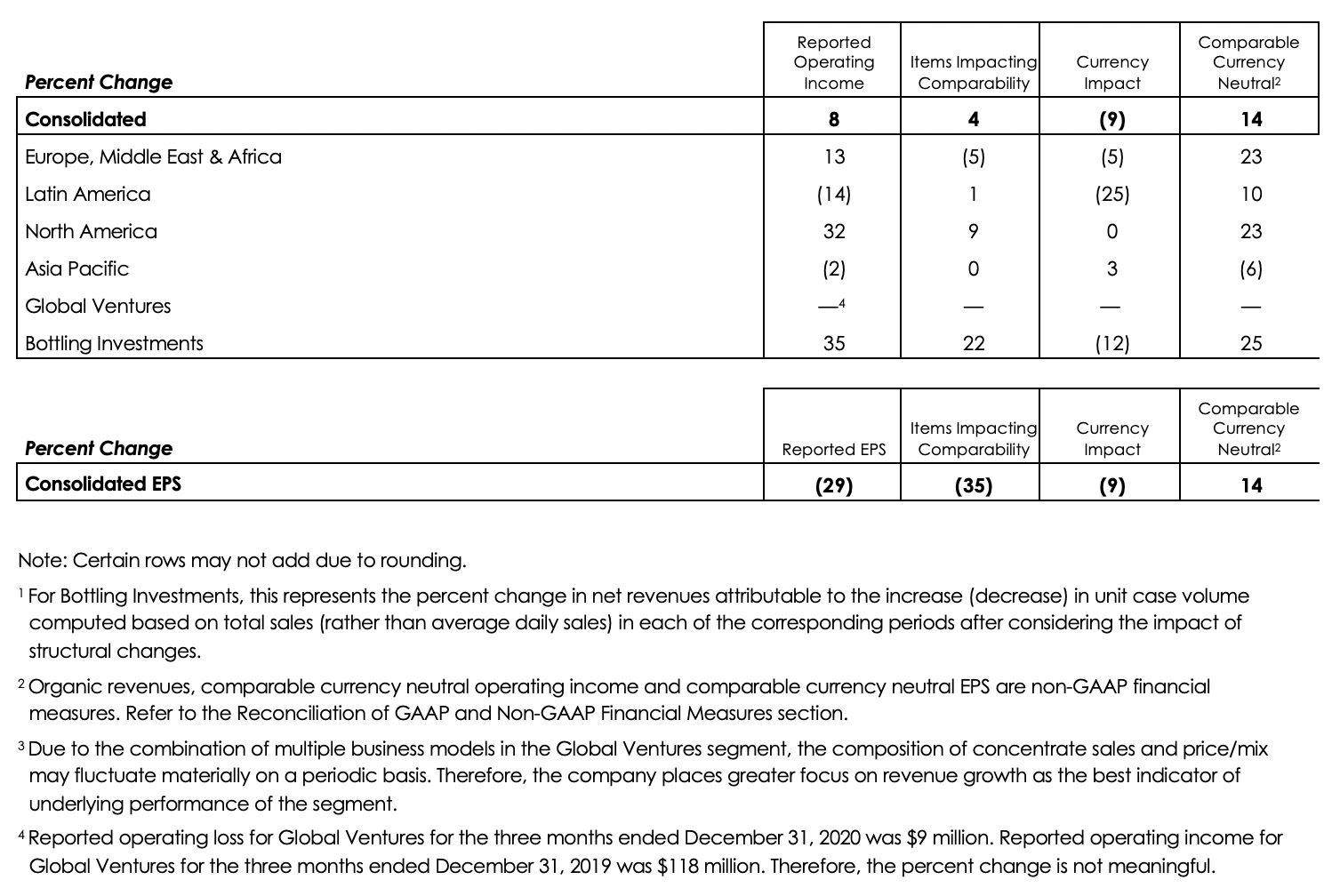
Operating Review – Year Ended December 31, 2020
Revenues and Volume

Operating Income and EPS
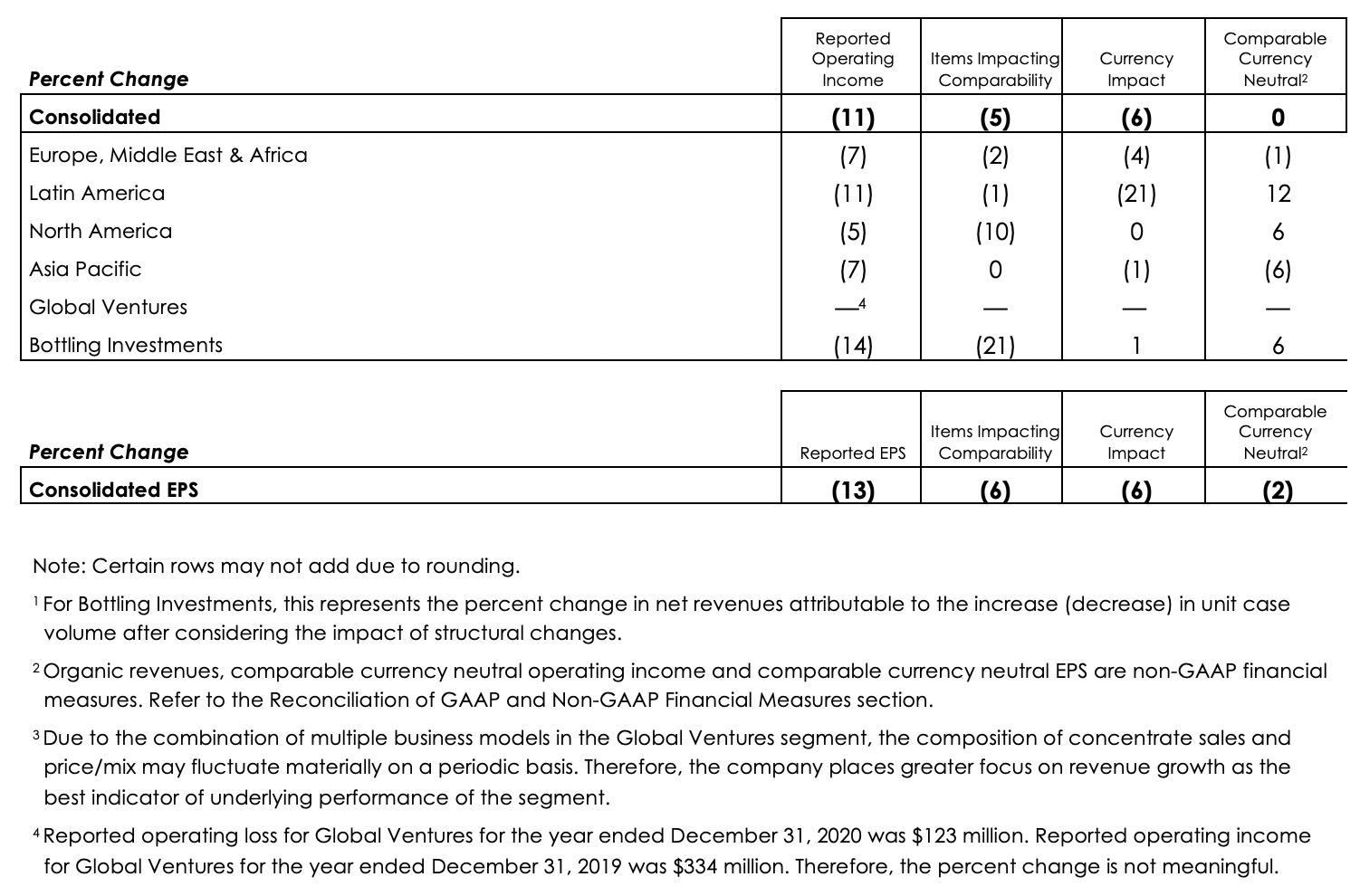
In addition to the data in the preceding tables, operating results included the following:
Consolidated
- Price/mix declined 3% for the quarter, driven by negative channel and package mix due to the impact of the coronavirus pandemic. Concentrate sales were 3 points ahead of unit case volume, primarily due to two additional days in the quarter (a 2-point benefit) and cycling the Brexit-related inventory reduction in the prior year. For the full year, concentrate sales were 1 point behind unit case volume, primarily due to the timing of shipments across operating groups.
- Unit case volume declined 3% for the quarter and 6% for the year, as continued strength in at-home channels was more than offset by coronavirus-related pressure in away-from-home channels. While developing and emerging markets remained resilient in the quarter, developed markets continued to be under pressure. Category cluster performance was as follows:
- Sparkling soft drinks declined 1% for the quarter and 4% for the year. For both the quarter and the full year, the decline was primarily due to pressure in the fountain business in North America and away-from-home channels in Western Europe due to the coronavirus pandemic. This was partially offset by growth in China, Brazil and Nigeria. Trademark Coca‑Cola grew 1% for the quarter and declined 1% for the year. Trademark Coca‑Cola growth in the quarter was driven by positive performance in most operating groups. Coca‑Cola® Zero Sugar grew 3% for the quarter and 4% for the year.
- Juice, dairy and plant-based beverages declined 2% for the quarter and 9% for the year, as solid performance by Simply® and fairlife® in North America was more than offset by a decline in Minute Maid® in the fountain business. Volume was further impacted by pressure in the Asia Pacific and Europe, Middle East & Africa operating groups.
- Water, enhanced water and sports drinks declined 9% for the quarter and 11% for the year, led by a broad-based decline across operating groups, primarily due to a decline in lower-margin water brands.
- Tea and coffee declined 15% for the quarter and 17% for the year, primarily driven by coronavirus-related pressure on Costa® retail stores, along with pressure on the doğadan® tea business in Turkey.
- Operating income grew 8% for the quarter and declined 11% for the year, which included items impacting comparability in addition to currency headwinds. Comparable currency neutral operating income (non-GAAP) grew 14% for the quarter and was even for the year, driven by effective cost management across operating groups offset by top-line pressure due to the coronavirus pandemic.
Europe, Middle East & Africa
- Price/mix declined 5% for the quarter driven by negative channel and package mix in Europe. Concentrate sales were 3 points ahead of unit case volume, largely due to two additional days in the quarter and cycling the Brexit-related inventory reduction in the prior year.
- Unit case volume declined 4% for the quarter, primarily due to coronavirus-related pressure in away-from-home channels in Europe and South Africa, partially offset by growth in Western Africa and Turkey.
- Operating income grew 13% in the quarter, impacted by headwinds from comparability items and currency. Comparable currency neutral operating income (non-GAAP) grew 23% driven by effective cost management.
- For the year, the company lost value share in total NARTD beverages, primarily due to share losses across most category clusters, partially offset by a share gain in sparkling soft drinks.
Latin America
- Price/mix declined 4% for the quarter driven by negative package mix along with cycling solid pricing in the prior year. Concentrate sales were 4 points ahead of unit case volume, driven by two additional days in the quarter and cycling the timing of shipments in Brazil in the prior year.
- Unit case volume grew 2% for the quarter, led by solid performance in sparkling soft drinks in Brazil, partially offset by a decline in away-from-home channels in Mexico.
- Operating income declined 14% in the quarter, which included items impacting comparability and a 25-point currency headwind. Comparable currency neutral operating income (non-GAAP) grew 10%, primarily due to effective cost management across all business units.
- For the year, the company gained value share in total NARTD beverages in addition to all category clusters.
North America
- Price/mix grew 3% for the quarter, as solid growth in juice and dairy finished-goods brands was partially offset by pressure in the fountain business and away-from-home channels. Concentrate sales were 1 point ahead of unit case volume, driven by two additional days in the quarter partially offset by the timing of shipments.
- Unit case volume declined 7% for the quarter, as strong growth in sparkling soft drinks in at-home channels along with growth in AHA®, fairlife® and Powerade Zero® was more than offset by a decline in the fountain business.
- Operating income grew 32% in the quarter, which included a tailwind from items impacting comparability. Comparable currency neutral operating income (non-GAAP) grew 23% driven by pricing and effective cost management.
- For the year, the company lost value share in total NARTD beverages due to coronavirus-related restrictions in away-from-home channels, where the company has a strong share position.
Asia Pacific
- Price/mix declined 1% for the quarter, primarily due to negative channel mix in key markets. Concentrate sales were 3 points behind unit case volume due to cycling the timing of shipments in China in the prior year, partially offset by two additional days in the quarter.
- Unit case volume declined 4% for the quarter, primarily due to adverse weather in Southeast Asia along with coronavirus-related pressure in away-from-home channels in most markets in the region. Volume performance included solid growth in sparkling soft drinks in China and India.
- Operating income declined 2% in the quarter, which included a 3-point currency tailwind. Comparable currency neutral operating income (non-GAAP) declined 6%, driven by pressure in away-from-home channels in Japan and Australia, partially offset by effective cost management.
- For the year, the company's value share in total NARTD beverages was even as a share gain in the tea and coffee category cluster was offset by share losses in the other category clusters.
Global Ventures
- Net revenues declined 14% in the quarter, which included a 2-point currency tailwind. Organic revenues (non-GAAP) declined 17%. The revenue declines were primarily driven by coronavirus-related pressure on Costa® retail stores, partially offset by strong performance in Costa® Express machines in the United Kingdom.
- The operating loss in the quarter was primarily driven by coronavirus-related pressure on Costa® retail stores.
Bottling Investments
- Price/mix grew 6% for the quarter driven by pricing and trade promotion optimization in most markets.
- Unit case volume declined 7% for the quarter, primarily due to the impact of the coronavirus pandemic across key markets and adverse weather in Southeast Asia.
- Operating income growth of 35% in the quarter included a tailwind from items impacting comparability and a headwind from currency. Comparable currency neutral operating income (non-GAAP) grew 25% driven by solid pricing and effective operating expense management.
Outlook
The 2021 outlook information provided below includes forward-looking non-GAAP financial measures, which management uses in measuring performance. The company is not able to reconcile full year 2021 projected organic revenues (non-GAAP) to full year 2021 projected reported net revenues, full year 2021 projected comparable net revenues (non-GAAP) to full year 2021 projected reported net revenues, full year 2021 projected underlying effective tax rate (non-GAAP) to full year 2021 projected reported effective tax rate or full year 2021 projected comparable EPS (non-GAAP) to full year 2021 projected reported EPS without unreasonable efforts because it is not possible to predict with a reasonable degree of certainty the actual impact of changes in foreign currency exchange rates; the exact timing and amount of acquisitions, divestitures and/or structural changes; and the exact timing and amount of comparability items throughout 2021. The unavailable information could have a significant impact on our full year 2021 reported financial results.
Full Year 2021
The company expects to deliver organic revenue (non-GAAP) percentage growth of high single digits.
For comparable net revenues (non-GAAP), the company expects a 2% to 3% currency tailwind based on the current rates and including the impact of hedged positions.
The company's underlying effective tax rate (non-GAAP) is estimated to be 19.5%.
Given the above considerations, the company expects to deliver comparable EPS (non-GAAP) percentage growth of high single digits to low double digits versus $1.95 in 2020. This includes a 3% to 4% currency tailwind based on the current rates and including the impact of hedged positions.
The company expects to deliver free cash flow (non-GAAP) of at least $8.5 billion through cash flow from operations of at least $10.0 billion and capital expenditures of approximately $1.5 billion. This does not include any potential payments related to the ongoing tax litigation with the IRS.
First Quarter 2021 Considerations
Comparable net revenues (non-GAAP) are expected to include a minimal currency impact based on the current rates and including the impact of hedged positions.
Comparable EPS (non-GAAP) is expected to include an approximate 2% currency headwind based on the current rates and including the impact of hedged positions.
The first quarter has five additional days compared to first quarter 2020.
Notes
- All references to growth rate percentages and share compare the results of the period to those of the prior year comparable period.
- All references to volume and volume percentage changes indicate unit case volume, unless otherwise noted. All volume percentage changes are computed based on average daily sales for the fourth quarter, unless otherwise noted, and are computed on a reported basis for the full year. "Unit case" means a unit of measurement equal to 192 U.S. fluid ounces of finished beverage (24 eight-ounce servings), with the exception of unit case equivalents for Costa® non-ready-to-drink beverage products which are primarily measured in number of transactions. "Unit case volume" means the number of unit cases (or unit case equivalents) of company beverages directly or indirectly sold by the company and its bottling partners to customers or consumers.
- "Concentrate sales" represents the amount of concentrates, syrups, beverage bases, source waters and powders/minerals (in all instances expressed in equivalent unit cases) sold by, or used in finished beverages sold by, the company to its bottling partners or other customers. For Costa® non-ready-to-drink beverage products, "concentrate sales" represents the amount of coffee beans and finished beverages (in all instances expressed in equivalent unit cases) sold by the company to customers or consumers. In the reconciliation of reported net revenues, "concentrate sales" represents the percent change in net revenues attributable to the increase (decrease) in concentrate sales volume for the geographic operating segments and the Global Ventures operating segment after considering the impact of structural changes. For the Bottling Investments operating segment for the fourth quarter, this represents the percent change in net revenues attributable to the increase (decrease) in unit case volume computed based on total sales (rather than average daily sales) in each of the corresponding periods after considering the impact of structural changes. For the Bottling Investments operating segment for the full year, this represents the percent change in net revenues attributable to the increase (decrease) in unit case volume after considering the impact of structural changes. The Bottling Investments operating segment reflects unit case volume growth for consolidated bottlers only.
- "Price/mix" represents the change in net operating revenues caused by factors such as price changes, the mix of products and packages sold, and the mix of channels and geographic territories where the sales occurred.
- First quarter 2020 financial results were impacted by one less day as compared to the same period in 2019, and fourth quarter 2020 financial results were impacted by two additional days as compared to the same period in 2019. Unit case volume results for the quarters are not impacted by the variances in days due to the average daily sales computation referenced above.
Conference Call
The company is hosting a conference call with investors and analysts to discuss fourth quarter and full year 2020 operating results today, Feb. 10, 2021, at 8:30 a.m. ET. The company invites participants to listen to a live webcast of the conference call on the company’s website, http://www.coca-colacompany.com, in the "Investors" section. An audio replay in downloadable digital format and a transcript of the call will be available on the website within 24 hours following the call. Further, the "Investors" section of the website includes certain supplemental information and a reconciliation of non-GAAP financial measures to the company’s results as reported under GAAP, which may be used during the call when discussing financial results.
Forward-Looking Statements
This press release may contain statements, estimates or projections that constitute “forward-looking statements” as defined under U.S. federal securities laws. Generally, the words “believe,” “expect,” “intend,” “estimate,” “anticipate,” “project,” “will” and similar expressions identify forward-looking statements, which generally are not historical in nature. Forward-looking statements are subject to certain risks and uncertainties that could cause The Coca‑Cola Company’s actual results to differ materially from its historical experience and our present expectations or projections. These risks include, but are not limited to, the negative impacts of the COVID-19 pandemic on our business; obesity and other health-related concerns; evolving consumer product and shopping preferences; increased competition; water scarcity and poor quality; increased demand for food products and decreased agricultural productivity; product safety and quality concerns; perceived negative health consequences of certain ingredients, such as non-nutritive sweeteners and biotechnology-derived substances, and of other substances present in our beverage products or packaging materials; an inability to be successful in our innovation activities; an inability to realize the economic benefits for our reorganization and related reduction in workforce; an inability to protect our information systems against service interruption, misappropriation of data or breaches of security; failure to comply with personal data protection and privacy laws; failure to digitize the Coca‑Cola system; changes in the retail landscape or the loss of key retail or foodservice customers; an inability to expand operations in emerging and developing markets; fluctuations in foreign currency exchange rates; interest rate increases; an inability to maintain good relationships with our bottling partners; a deterioration in our bottling partners’ financial condition; increases in income tax rates, changes in income tax laws or unfavorable resolution of tax matters, including the outcome of our ongoing tax dispute or any related disputes with the U.S. Internal Revenue Service; increased or new indirect taxes in the United States and throughout the world; an inability to successfully manage the possible negative consequences of our productivity initiatives; an inability to attract or retain a highly skilled and diverse workforce; increased cost, disruption of supply or shortage of energy or fuel; increased cost, disruption of supply or shortage of ingredients, other raw materials, packaging materials, aluminum cans and other containers; increasing concerns about the environmental impact of plastic bottles and other plastic packaging materials; changes in laws and regulations relating to beverage containers and packaging; significant additional labeling or warning requirements or limitations on the marketing or sale of our products; unfavorable general economic conditions in the United States; unfavorable economic and political conditions in international markets; unfavorable outcome of litigation or legal proceedings; conducting business in markets with high-risk legal compliance environments; failure by our third-party service providers and business partners to satisfactorily fulfill their commitments and responsibilities; failure to adequately protect, or disputes relating to, trademarks, formulae and other intellectual property rights; adverse weather conditions; climate change and legal or regulatory responses thereto; damage to our brand image, corporate reputation and social license to operate from negative publicity, whether or not warranted, concerning product safety or quality, workplace and human rights, obesity or other issues; changes in, or failure to comply with, the laws and regulations applicable to our products or our business operations; changes in accounting standards; an inability to achieve our overall long-term growth objectives; deterioration of global credit market conditions; default by or failure of one or more of our counterparty financial institutions; an inability to renew collective bargaining agreements on satisfactory terms, or we or our bottling partners experience strikes, work stoppages or labor unrest; future impairment charges; multi-employer pension plan withdrawal liabilities in the future; an inability to successfully integrate and manage our company-owned or -controlled bottling operations or other acquired businesses or brands; an inability to successfully manage our refranchising activities; failure to realize a significant portion of the anticipated benefits of our strategic relationship with Monster Beverage Corporation; global or regional catastrophic events; and other risks discussed in our filings with the SEC, including our Annual Report on Form 10-K for the year ended December 31, 2019 and our subsequently filed Quarterly Reports on Form 10-Q and other reports, which filings are available from the SEC. You should not place undue reliance on forward-looking statements, which speak only as of the date they are made. We undertake no obligation to publicly update or revise any forward-looking statements.
